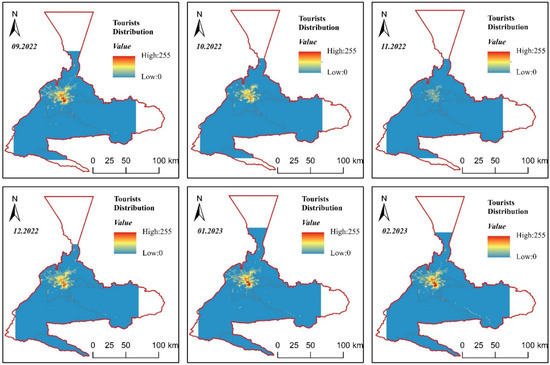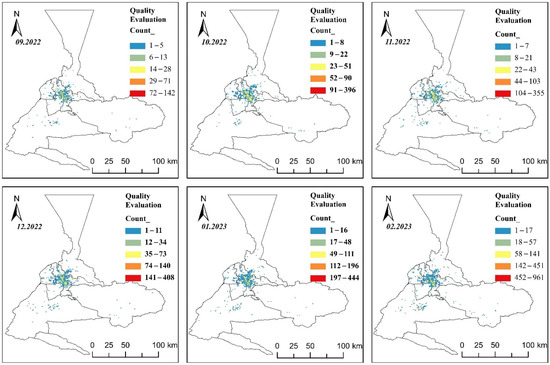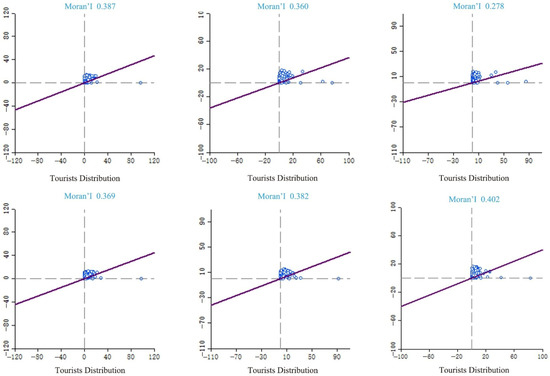1. Introduction
With the rapid development of the economy and the continuous improvement in people’s living standards, tourism has become a way of improving quality of life and expressing individuality. A tourism destination is a region where tourist activities take place; this can be either a special tourist site or any area in a city where tourist activities occur. It is one of the most important parts of the entire tourism process. Creating high-quality tourism destinations can provide tourists with high-quality experiences and improve the overall living environments in an area, thereby pleasing locals and attracting visitors from far and wide. Therefore, for tourists, choosing high-quality tourism destinations is important for obtaining a good tourism experience.
The factors determining the selection of a tourism destination can be divided into two categories. One is the tourist’s own motivation for travelling, which specifically includes factors such as escaping familiar environments, leisure and relaxation, expanding their horizons, pursuing physical and mental health, socializing, and nostalgia. The other includes the individual characteristics of the tourist, such as gender, age, income, education level, and family commitments. These have important effects on an individual’s choice of tourism destination. Tourists may also develop a desire to travel due to the perceived attractions of a particular tourism destination. This can be affected by information stimulus, i.e., various factors that affect the subjective perceptions, decisions, and behaviors of tourists such as advertising, online posts, word-of-mouth marketing (WOMM), recommendations from friends and relatives, travelogues, and information published on various travel forums and in virtual communities. Destination factors also play a role, and these can be divided into two categories: destination attributes and destination resources. Destination attributes are abstract summaries of the basic characteristics of a destination, including the destination’s image, its perceived distance, its local social environment, its transportation conditions, the cost, etc. Destination resources are the specific tourism attractions that the destination possesses and the tourism products and services developed based on these. They can include natural resources, such as the seaside, forests, hot springs, and grasslands, as well as cultural resources, such as ethnic customs, folk activities, intangible cultural heritage, and corresponding tourism products. Additionally, journey factors are a newly emerging type of influencing factor that are quite different from those traditionally affecting tourism. The processes by which tourists choose tourism destinations are thus very important and complicated. How to choose high-quality tourism destinations is an important consideration for the development of tourism-related studies, and it is also of great importance to tourists and tourism management departments (tourism management departments include administrative authorities responsible for local tourism industries, such as the Department of Culture and Tourism, as well as actual destination management organizations, such as scenic area operational departments) (Table 1).
Table 1. Attractive elements of tourism destinations.
| Attractive elements of tourism destinations |
Destination information stimuli |
Destination information stimuli encompass various factors that influence tourists’ subjective perceptions and decision-making behaviors. These stimuli include destination advertisements, online posts, word-of-mouth marketing, recommendations from friends and relatives, travelogues, and travel guides posted on various tourism forums and in virtual communities. |
| Destination attributes |
Destination attributes are abstract summarizations of a destination’s basic characteristics. These include destination image, perceived distance, local social environment, transportation conditions, and cost. |
| Destination resources |
Destination resources are the specific tourist attractions a destination possesses, as well as the corresponding tourism products and services. These can include natural resources, such as beaches, forests, hot springs, and grasslands, as well as cultural resources, such as ethnic customs, folklore activities, intangible cultural heritage projects, and corresponding tourism products. |
| Travel factors |
Travel factors specifically refer to the different influencing factors that lead tourists to choose different travel destinations during their travel experiences. |
2. Temporal and Spatial Distribution of Tourists at Different Tourism Destinations
Tourist destinations refer to specific regions with certain tourism resources and attractions that are capable of attracting a certain number of tourists for travel activities. This makes their definition more extensive compared to traditional tourist attractions. Due to the lack of studies on the spatial division and identification of tourist destinations in Urumqi, researchers used the distribution range of tourists in Urumqi to define the spatial scope of tourist destinations. Based on the characteristics of Tencent migration big data, researchers selected the data with migration destinations within the Urumqi urban area, while migration origins outside the Urumqi urban area served as the data source for incoming tourists. To avoid errors, researchers conducted a comprehensive average analysis of the monthly number and distribution range of tourist migration, ultimately obtaining the spatial distribution of tourists and tourist destinations from September 2022 to February 2023. According to the Tencent migration data reflecting the number of tourists, there were obvious differences in tourist numbers during different periods, indicating that different tourist destinations in Urumqi have varying degrees of attractiveness to tourists during different periods. Furthermore, by analyzing the Tencent migration data origins and destinations during different periods, it was found that, overall, from September 2022 to February 2023 tourists came to Urumqi primarily from the eastern coastal regions of China, such as Guangdong, Fujian, and Zhejiang, while in the specific months of October and November 2022, tourists mainly came from Fujian, Zhejiang, Shandong, and Shanghai. After December 2022, more tourists came from Guangdong and Zhejiang. The origin of tourists also reflected local epidemic policies, particularly during the period from October to December 2022 when Guangdong and other regions implemented strict epidemic prevention and control measures, resulting in a significant decrease in the number of tourists from those regions. On the other hand, it can be seen that tourist flows were not only related to regional population and economic levels but also influenced by unexpected events. Additionally, the behaviors and characteristics of tourists from different regions can have different effects on tourist attractions.
The spatial distribution characteristics of Urumqi’s tourism destinations show that they were mainly concentrated in the Xinshi District, Shuimogou District, Toutunhe District, Shayibake District, and Tianshan District, while their concentrations in the Midong District, Urumqi County, and the Dabancheng District were relatively low. Additionally, there was a significant difference between the spatial distribution of tourism destinations and that of tourist attractions. This was mainly due to the fact that tourist attractions were generally more scattered, while tourism destinations in Urumqi were relatively concentrated, indicating that tourists’ choices of tourism destinations did not directly depend on the distribution of tourist attractions. In terms of the spatial distribution of tourists, from September 2022 to February 2023, tourists were mainly concentrated in the Xinshi District, Shuimogou District, Toutunhe District, Shayibake District, and Tianshan District, but the number and distribution range of tourists during different periods differed significantly. Considering the characteristics of different districts in Urumqi and the spatial distribution of tourists, it can be seen that Xinshi District, Shuimogou District, Toutunhe District, Shayibake District, and Tianshan District are the main areas in Urumqi with significant economic, cultural, and ethnic features. These areas offer ethnic scenery that cannot be experienced elsewhere, making them particularly attractive to visitors. However, some more common landscapes, such as the Forest Park in Urumqi County, are often overlooked.
The tourists’ aggregation showed a trend of first decreasing and then increasing, especially in October and November 2022, which is the golden season for tourism. The number of tourists in Urumqi was relatively low due to the strict control measures against the COVID-19 pandemic but increased significantly after the pandemic eased in December. In terms of the distribution range, from September to December 2022, more tourists were distributed in the Tianshan District and the Xinshi District, while in January and February 2023, more tourists were distributed in the Shuimogou District and the Shayibake District (Figure 1).
Figure 1. The temporal and spatial distribution of tourists in Urumqi.
3. Quality Analysis of Different Tourism Destinations
The quality of a tourism destination generally depends on the tourists’ comprehensive experience, including food and consumption, which is often difficult to express quantitatively. However, Weibo sign-in big data include sign-in content and number of followers, so researchers selected the positive evaluation data in regard to the tourism destination based on the characteristics of the Weibo sign-in big data, where a higher number of followers indicated a higher quality evaluation of the tourism destination. Researchers summarized and analyzed all sign-in data from September 2022 to February 2023 to obtain the quality evaluation results of different tourism destinations in Urumqi.
From the quality analysis using the Weibo sign-in big data, it can be seen that the tourism destinations with higher quality were mainly distributed in the Xinshi District, Shuimogou District, Toutunhe District, Shayibake District, and Tianshan District, and there were also many high-quality tourism destinations in the Dabancheng District. The spatial distribution was comparable to the spatial distribution of tourists, indicating that the number of tourists does indeed correlate with the quality of tourism destinations to some extent. However, high-quality tourism destinations were more often found in the Xinshi District, the outer areas of Tianshan District, and the Dabancheng District, a distribution pattern that showed some differences compared to the spatial distribution of tourists. This is most likely because foreign tourists are often attracted to non-homogeneous and niche tourism destinations, which often provide different experiences, and they may recommend these tourism destinations on social platforms. From the quality analysis of tourism destinations during different periods, it can be seen that from September 2022 to February 2023 there was an obvious decline in the quality evaluations for the same tourism destinations, which was due to the fact that various tourism facilities had not been restored promptly after the COVID-19 pandemic, resulting in a less satisfactory experience for tourists in Urumqi. Overall, the quality analysis of tourism destinations reflected the degree of attraction of tourists to different tourism destinations and the tourists’ travel experience (Figure 2).
Figure 2. Quality analysis of Urumqi’s tourism destinations.
4. Spatial Correlation between the Quality of Different Tourism Destinations and the Spatial-Temporal Distribution of Tourists
For tourists, finding high-quality tourism destinations generally involves information from two sources: official and private. Official information generally comes from tourism departments that introduce tourism destinations. These departments mainly focus on high-class scenic areas, such as China’s 3A-, 4A-, and 5A-rated scenic spots (in China, tourist attractions are classified into five levels of quality, ranked from highest to lowest as follows: AAAAA, AAAA, AAA, AA, and A, and the level of an A-rated attraction is an important indicator of its quality in China), and the introductions are often one-sided for the sake of attracting more tourists. The private information pathway generally involves tourists finding relevant information about tourism destinations on the internet; however, the information on the internet is generally mixed, so being able to access high-quality tourism destinations can greatly improve their travel experience. Tourism management departments manage the operation of different tourism destinations; however, they generally focus on developing high-class tourist attractions, leaving the development and management of some ordinary tourism destinations somewhat lacking. If tourism management departments can obtain information on high-quality tourism destinations, it will have great benefits for the development and management of tourism.
Therefore, in order to better understand the relationship between the spatial distribution of tourists and high-quality tourism destinations, researchers used Bivariate Moran’s I analysis. The results of the Moran scatter plot and spatial interaction indicate the correlation between high-quality tourism destinations and the spatial distribution of tourists. It can be seen that there was not a strong correlation between the spatial distribution of tourists and the overall evaluation of the tourism destination. Areas with a more concentrated distribution of tourists did not necessarily have higher tourism quality. Furthermore, according to the result of the Moran scatter plot, the Moran index showed a trend of first decreasing and then increasing, which indicates that the COVID-19 epidemic may have had an important impact on tourists’ choices of destinations. In addition, some tourism destinations may not have opened due to epidemic prevention and control measures (Figure 3).
Figure 3. Moran scatter plot.
The spatial interaction results are shown in Figure 4, which demonstrates four different clustering patterns, HH, HL, LH, and LL. These clustering patterns were used to represent the spatial relationship between the distribution of tourists and the quality of tourism destinations. The HH clustering result represents areas with high tourist density and high tourism quality, HL represents areas with high tourist density but low tourism quality, LH represents areas with low tourist density but high tourism quality, and LL represents areas with low tourist density and low tourism quality. During the period from September 2022 to February 2023, there were some differences in the spatial clustering results, especially in the HH clustering and LH clustering. The HH clustering was mainly concentrated in the Xinshi District, Shuimogou District, Toutunhe District, Shayibake District, and Tianshan District. However, the range of HH clustering showed a trend of first shrinking and then expanding from September 2022 to February 2023, and the main HH clustering gradually shifted from the Xinshi District to the Tianshan District. The LL clustering was mainly distributed in the Xinshi District and the outer areas of the Tianshan District, as well as in the Dabancheng District. Furthermore, there was greater LH clustering in the Dabancheng District, and the spatial range was relatively stable across different periods.
Figure 4. Spatial clustering results.
As one of the most important means to improve quality of life, the importance of tourism has been gradually revealed, making the quality of tourism destinations is also receiving attention from both tourists and tourism management departments. From the perspective of tourists and tourism management departments, researchers focus on the importance of the quality of tourism destination to tourists and tourism management departments. Based on the spatial correlation between the spatial distribution of tourists and the quality evaluation results of tourism destination, four kinds of links between them are creatively proposed, and not only high-quality tourism destination is obtained, some niche tourism destinations with less tourist distribution but higher tourism destination quality are also obtained. For tourists, it not only improves the choice of tourism destination, but also indirectly improves the tourism experience. For the tourism management department, it provides an important reference for the management and development of regional tourism. Finally, although researchers take the tourism destination of Urumqi, China as a case study, the research results can be extended to other tourism destinations, which is of great significance to the development and research of tourism-related industries.









